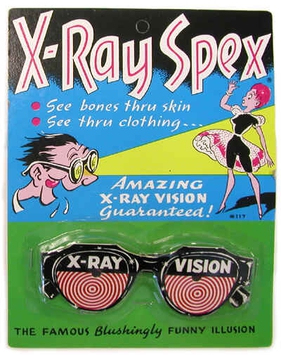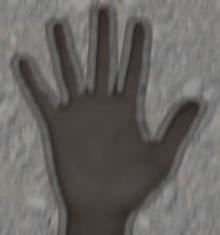X-ray specs
X-ray specs are a novelty item, often found in comic books and novelty stores, which claim to allow the user to see through solid objects. Despite their name, X-ray specs do not actually utilize X-ray technology. Instead, they are constructed from cardboard or plastic and contain a feather or similar object between two layers of cardboard with a hole cut out for the user to look through. This creates an optical illusion that can make it seem as though the viewer is seeing through solid objects, though the effect is purely a trick of the eye and does not involve any real penetration of materials.
Design and Function[edit | edit source]
The design of X-ray specs typically involves a simple, often comic-book-style, appearance, with the promise of allowing the wearer to "see through" materials. The illusion of seeing through objects is achieved not through any form of radiation or genuine X-ray technology but through a clever optical illusion. This is usually accomplished by the use of a feather or other patterned object placed within the glasses, which creates a diffraction pattern when viewed against a light source. This pattern can give the illusion of seeing past the surface of objects when, in reality, it merely overlays a pattern onto whatever the wearer is looking at.
Cultural Impact[edit | edit source]
X-ray specs have become a part of popular culture, often symbolizing the allure of forbidden knowledge or the desire to possess superhuman abilities. They have been featured in various forms of media, including comic books, television shows, and movies, usually as a humorous gadget that promises more than it can deliver. The concept of X-ray specs taps into the human fascination with the idea of seeing the unseen or revealing hidden aspects of the world around us.
Scientific Reality[edit | edit source]
In reality, the concept of seeing through solid objects requires the use of actual X-ray technology, which involves the emission of X-rays, a form of electromagnetic radiation, through objects. Different materials absorb X-rays to different extents, which is why medical X-rays can show bones as white on an X-ray film, with softer tissues appearing in shades of gray. The use of real X-rays for non-medical purposes, especially without proper safety measures, would be dangerous due to the potential for radiation exposure.
Conclusion[edit | edit source]
While X-ray specs are a playful and imaginative novelty item, they bear no relation to the actual science of X-ray imaging. They serve as a reminder of the human desire for superhuman powers and the appeal of the mysterious and unknown. Despite their lack of real functionality, X-ray specs remain a popular and iconic novelty item, representing a unique aspect of pop culture and the enduring appeal of optical illusions.
Search WikiMD
Ad.Tired of being Overweight? Try W8MD's physician weight loss program.
Semaglutide (Ozempic / Wegovy and Tirzepatide (Mounjaro / Zepbound) available.
Advertise on WikiMD
|
WikiMD's Wellness Encyclopedia |
| Let Food Be Thy Medicine Medicine Thy Food - Hippocrates |
Translate this page: - East Asian
中文,
日本,
한국어,
South Asian
हिन्दी,
தமிழ்,
తెలుగు,
Urdu,
ಕನ್ನಡ,
Southeast Asian
Indonesian,
Vietnamese,
Thai,
မြန်မာဘာသာ,
বাংলা
European
español,
Deutsch,
français,
Greek,
português do Brasil,
polski,
română,
русский,
Nederlands,
norsk,
svenska,
suomi,
Italian
Middle Eastern & African
عربى,
Turkish,
Persian,
Hebrew,
Afrikaans,
isiZulu,
Kiswahili,
Other
Bulgarian,
Hungarian,
Czech,
Swedish,
മലയാളം,
मराठी,
ਪੰਜਾਬੀ,
ગુજરાતી,
Portuguese,
Ukrainian
Medical Disclaimer: WikiMD is not a substitute for professional medical advice. The information on WikiMD is provided as an information resource only, may be incorrect, outdated or misleading, and is not to be used or relied on for any diagnostic or treatment purposes. Please consult your health care provider before making any healthcare decisions or for guidance about a specific medical condition. WikiMD expressly disclaims responsibility, and shall have no liability, for any damages, loss, injury, or liability whatsoever suffered as a result of your reliance on the information contained in this site. By visiting this site you agree to the foregoing terms and conditions, which may from time to time be changed or supplemented by WikiMD. If you do not agree to the foregoing terms and conditions, you should not enter or use this site. See full disclaimer.
Credits:Most images are courtesy of Wikimedia commons, and templates, categories Wikipedia, licensed under CC BY SA or similar.
Contributors: Prab R. Tumpati, MD


